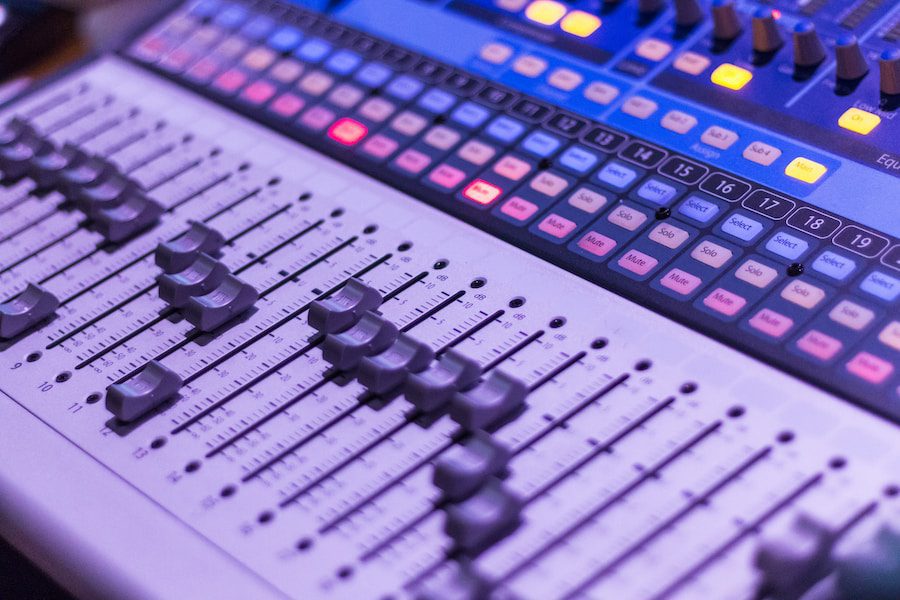A cue mix is essential for musicians and recording engineers in recording and mixing audio tracks. A well-balanced cue mix ensures that the performer can focus on their performance and achieve the desired expression and emotion in their recordings.
A cue mix, also known as a monitor mix or a headphone mix, is a personalized monitor mix that is sent to the performer’s headphones or in-ear monitors (IEMs) during a recording or live performance. A cue mix typically allows the performer to hear a combination of individual instruments or vocals that are specific to their needs, including their instrument or voice in the mix.
Creating a cue mix involves adjusting the levels of individual channels, such as vocals, drums, and guitars, in a way tailored to each performer’s preferences. This customization allows the musician to hear themselves more clearly and feel more comfortable and confident during the recording session. A great cue mix can make a huge difference in the performance quality, leading to better overall results in the final recording.
The cue mix is especially vital when a live band is recording together, as a proper balance between instruments and vocals is critical for maintaining proper timing and musical cohesion. Additionally, the cue mix can be adjusted throughout the recording process to account for changes in the performance dynamics, ensuring that the musicians always have the optimal listening environment while performing.
Table of Contents

Essentials of Cue Mix
A cue mix is essential for recording artists and audio engineers to monitor the audio signal from multiple sources. It allows them to create a custom mix of tracks that can be heard in real-time during the recording process.
Purpose of a Cue Mix
The primary purpose of a cue mix is to provide musicians and vocalists with the necessary audio feedback while performing in a studio or live setting. A well-crafted cue mix assists in maintaining proper pitch, rhythm, and tempo, facilitating a seamless and high-quality recording process.
Key Components
There are several key components to consider when creating a cue mix, which includes the proper balance of audio sources, effective routing, and monitoring methods. Here is a brief overview:
- Balance: Striking the right balance of audio sources in the cue mix is crucial. Levels of individual audio tracks, including the performer’s voice or instrument, must be optimal for them to hear themselves and other recorded elements.
- Routing: Efficient routing of audio signals is essential to avoid latency, which can cause problems with the performer’s timing. Digital audio workstations (DAWs) and mixers often have dedicated routing channels to create custom cue mixes for different performers.
- Monitoring: The type of monitoring system used can directly impact the effectiveness of the cue mix. Headphones, in-ear monitors, and speaker systems are common options, each offering unique advantages and challenges.
By understanding and implementing these fundamental aspects, audio engineers and performers can create effective cue mixes for an optimal recording experience.
Benefits of a Cue Mix
A cue mix provides several advantages for musicians and audio engineers during the recording and mixing. This section will discuss the benefits of using a cue mix, including improved monitoring and tracking and separate volume and effect control.
Monitoring and Tracking
When recording multiple instruments and vocals, a cue mix allows each performer to hear themselves and their fellow musicians at an appropriate volume level. This helps them maintain a steady tempo, play in tune, and stay focused throughout the recording session. Additionally, it enables the audio engineer to monitor the overall mix and make adjustments as needed, thus ensuring a quality recording.
Separate Volume and Effect Control
One of the main advantages of a cue mix is the ability to make individual adjustments to each performer’s monitor mix. This includes tweaking volume levels and applying custom effects such as reverb, compression, and equalization.
- Volume Levels: With a cue mix, each musician can have a monitor mix that emphasizes the parts they need to hear, helping them perform better. For example, a drummer may want more bass in their mix, while a vocalist might prefer hearing more of their voice.
- Effects: Applying custom effects to individual tracks within the cue mix can help musicians hear their parts more clearly and accurately, contributing to better overall performance. For instance, adding reverb to a vocalist’s monitor mix can help them maintain pitch and phrasing. In contrast, subtle compression on a guitarist’s track can help them articulate notes and chords more effectively.
In summary, the benefits of a cue mix lie in its ability to provide a tailored and controlled monitoring environment for both musicians and audio engineers, resulting in a more efficient and productive recording process.
Creating a Cue Mix
A cue mix is essential for musicians and sound engineers to monitor specific audio signals during recording, rehearsal, or live performances. Creating a cue mix involves selecting an appropriate audio interface, considering the software, and routing the signals effectively.
Audio Interface Selection
Choosing the right audio interface is crucial for setting up a cue mix. Consider the following factors while selecting an audio interface:
- Number of inputs and outputs: Depending on the setup, you may require multiple inputs and outputs for various instruments and monitoring systems.
- Quality of preamps: High-quality preamps ensure a clean and accurate audio signal for better monitoring and recording.
- Latency: Low latency audio interfaces ensure real-time monitoring and prevent audio delay.
Software Considerations
Software plays a critical role in the creation of a cue mix. Some audio interfaces come bundled with a digital audio workstation (DAW), or one can choose from a wide range of options. The software should support:
- Creating multiple cue mix outputs.
- Routing signals from various channels.
- Adjusting levels and panning for each output.
It’s essential to familiarize oneself with the software’s capabilities, as this greatly impacts the efficiency and effectiveness of the cue mix process.
Routing the Signals
After selecting an audio interface and software, routing the signals properly is the next step in creating a cue mix. Here are a few steps to consider:
- Connect the instruments and monitoring systems to the audio interface’s inputs and outputs.
- In the DAW, assign each input to a separate recording track.
- Create additional output channels in the DAW for the cue mixes.
- Route the input signals to the desired cue mix outputs.
- Adjust the levels and panning for each output to achieve the desired mix.
Following these steps will help create an effective cue mix, allowing musicians and sound engineers to monitor audio signals better and enhance their performances.
Mixing Techniques
There are several techniques involved in creating a cue mix. These techniques allow engineers to create professional and well-balanced mixes. This section will focus on three key areas: Master Clock Sync, Fader Adjustments, and Avoiding Latency.
Master Clock Sync
The master clock sync ensures the synchronization of all devices in a recording session. This is important to maintain the accuracy of the cue mix and prevent any timing issues.
There are two main options for sync setups: using a digital audio workstation (DAW) as the master clock or utilizing an external clock source. The choice of synchronization method will depend on various factors, such as the equipment used, the number of devices to be synced, and the overall setup complexity.
Fader Adjustments
Fader adjustments play a crucial role in creating a balanced cue mix. They allow the mix engineer to control and blend individual tracks’ levels.
- Volume Balance: Adjusting the fader levels to create a balanced mix will help the musicians to monitor their performance accurately.
- Pan Controls: Panning the audio tracks to create a stereo image is vital for an immersive listening experience.
- Automation: Automation can facilitate more complex adjustments, such as changing volume levels or panning positions throughout the mix.
Avoiding Latency
Latency can be a significant issue in a cue mix, as it can cause a delay between the musician’s performance and what they hear in their headphones. This can be disruptive and make it difficult for them to perform accurately.
Some ways to minimize latency include:
| Method | Description |
|---|---|
| Direct Monitoring | Direct monitoring features in audio interfaces allow the musician to hear their performance in real-time without going through the DAW. |
| Buffer Size | Reducing the buffer size in the DAW’s settings can help decrease latency. However, it may increase the chance of audio dropouts and system errors. |
| Necessary Plugins | Only using essential plugins during the recording process and disabling any additional ones can help reduce latency. |
Conclusion
In summary, a cue mix is essential for musicians, engineers, and producers during the recording process. It allows everyone involved to hear what they need to perform and record at their best. A well-crafted cue mix can contribute to better performances, as it enables musicians to focus on their playing and singing rather than getting distracted by insecurities or discomfort.
Setting up a cue mix involves using a mixing console, audio interface, or digital audio workstation (DAW) to create a custom mix for each musician. This is accomplished by adjusting levels, panning, and applying effects like reverb or EQ, if necessary. It is vital to communicate with the musicians to ensure their mix is tailored to their preferences and requirements, ultimately leading to a more successful recording session.
As demonstrated, the benefits of a cue mix extend beyond just the musicians’ comfort. Enhancing the studio experience promotes creativity and enables the capture of the best possible performances. Furthermore, a well-executed cue mix exemplifies professionalism in the recording studio, as it reflects an understanding of the needs and expectations of the artists involved. In this light, the importance of a high-quality cue mix cannot be overstated for the recording process’s technical and creative aspects.
- Review of the ALABS IRON MINI-WL: A Powerhouse Wireless Microphone - October 4, 2023
- What is a Saturator in Music Production: A Brief Explanation - May 11, 2023
- What Are Rotary DJ Mixers? An Overview - May 11, 2023
SoundStudiomagic.com is a participant in the Amazon Services LLC Associates Program, an affiliate advertising program designed to provide a means for sites to earn advertising fees by advertising and linking to Amazon.com. We also participate in other affiliate programs which compensate us for referring traffic.

